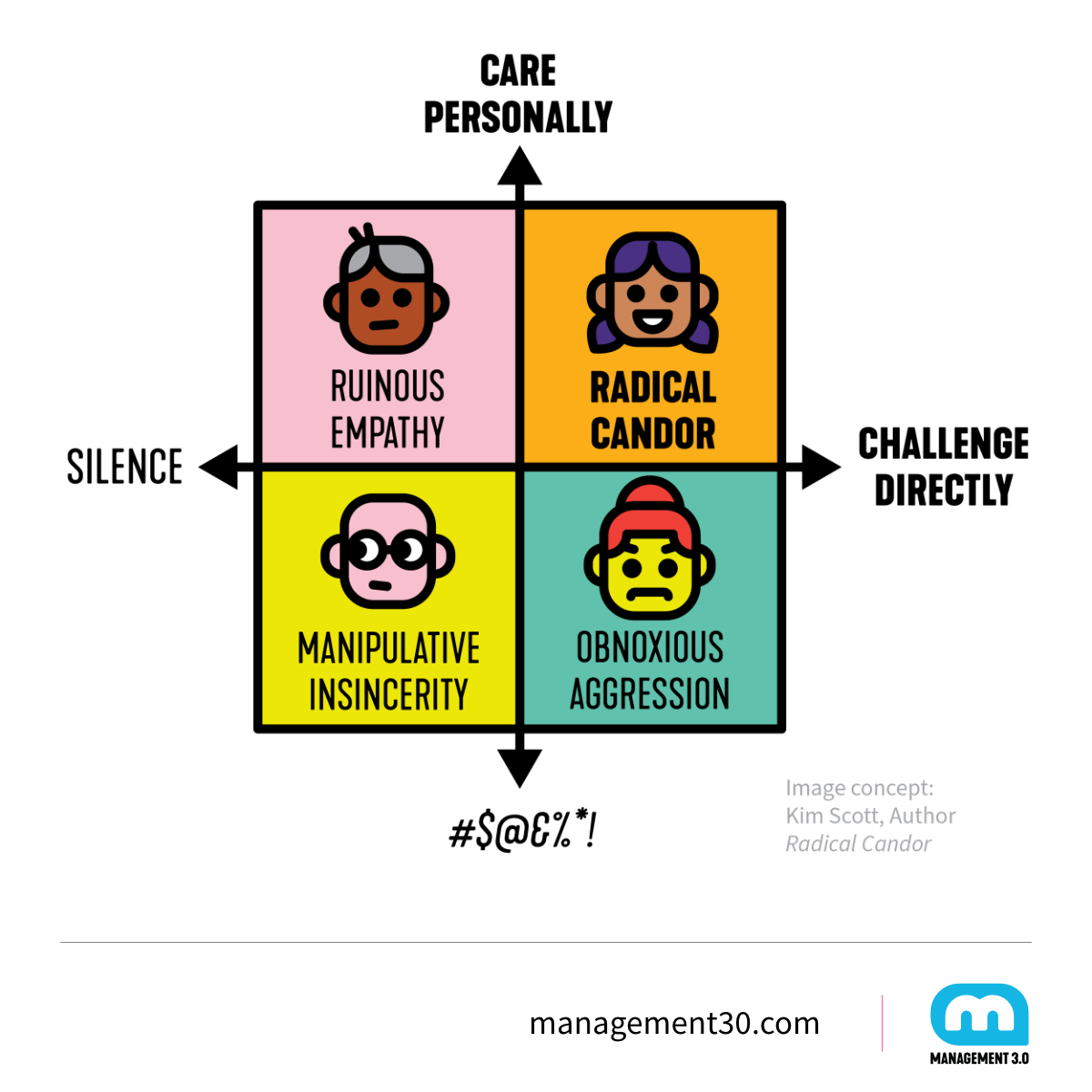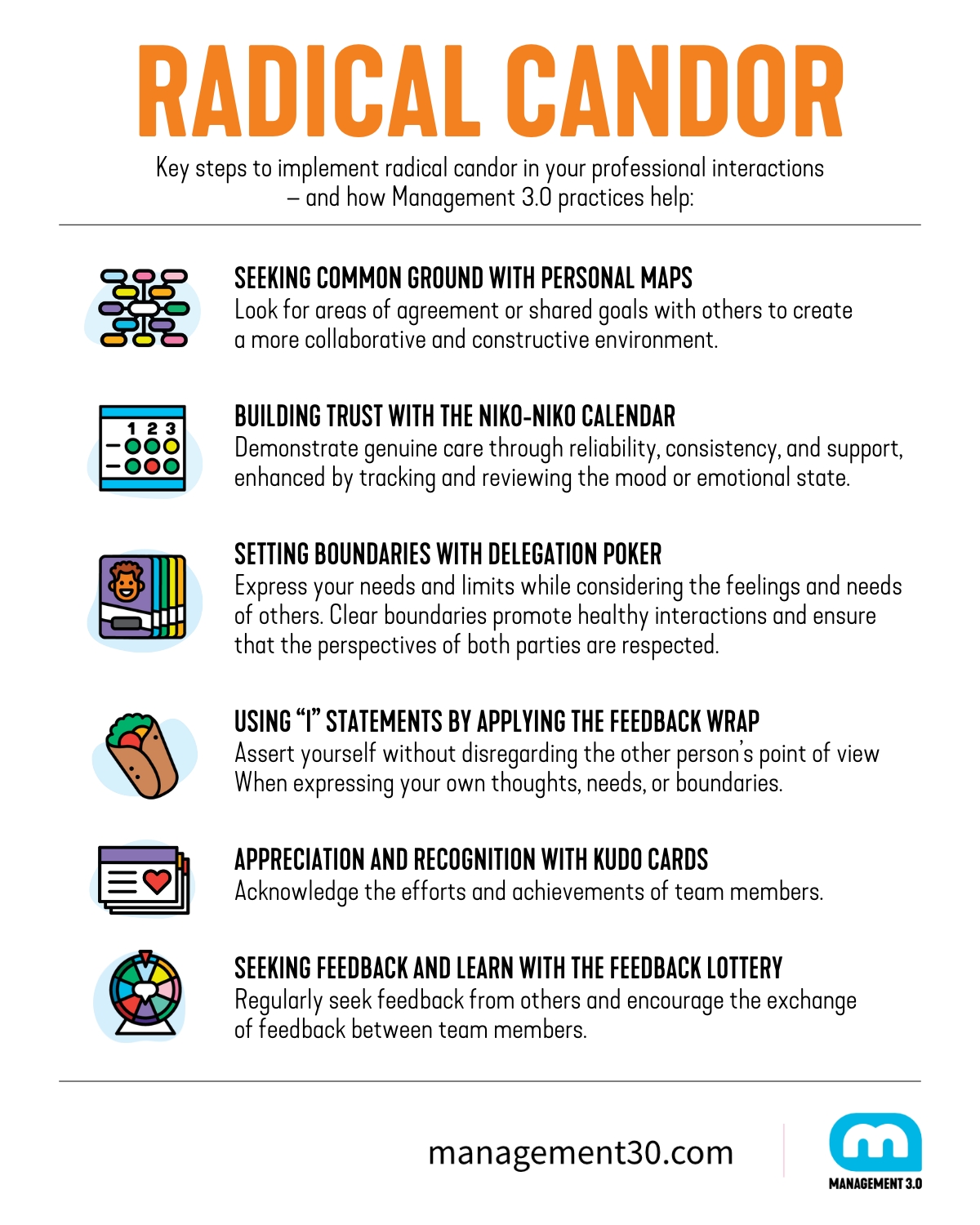Effective and empathetic communication plays a crucial role in the workplace, especially when encouraging collaboration, engagement, and team productivity. In this article, Management 3.0 Facilitator Andre Cruz explores the relationship between assertive empathy, as presented in Kim Scott’s book Radical Candor, and Management 3.0 practices. He demonstrates how these concepts complement each other, while offering concrete strategies for improving communication and building healthy relationships in the workplace.
Developing Radical Candor
In Radical Candor, author Kim Scott highlights the importance of balancing genuine empathy with the ability to provide constructive feedback. She introduces the concept of ‘radical candor’ as one which encourages sincerity in interactions while considering the emotional impact of words on others. Kim Scott encourages us to create a safe and trusting environment in which people feel comfortable expressing their opinions and receiving honest feedback.
Radical Candor refers to a communication style and approach through which an individual expresses understanding and compassion while maintaining a confident and self-assured manner. It involves actively listening to others, acknowledging their feelings and experiences, and demonstrating empathy, all while effectively asserting personal thoughts, needs, and boundaries.
It’s not brutal honesty. Radical Candor really just means saying what you think while also giving a damn about the person you’re saying it to.
www.radicalcandor.com
The Importance of Empathetic Communication
Radical Candor highlights several important concepts, with a central focus on active listening, understanding others’ perspectives, and recognizing the impact that our words and actions have on them. These principles are effectively applied through the adoption of Management 3.0 practices.
Many Management 3.0 practices promote transparent communication, recognition and appreciation of individual contributions, and the creation of an inclusive environment which values diverse opinions and experiences. By embracing these principles, organizations can foster a more collaborative and harmonious work culture – and this is why combining Kim Scott’s approach with Management 3.0 makes it even more effective!
To deepen our insights, here are the seven qualities of Emotionally Intelligent people: Change-agent Abilities, Self-Awareness, Empathetic, Not Perfectionist, Balanced, Curious, and Gracious. See how our Emotional Intelligence module can help you to become a more effective and empathetic leader.
The Graph of Radical Candor
Radical Candor is a framework represented by a two-by-two matrix defined by two dimensions: “Care Personally” and “Challenge Directly.”
- The “Care Personally” dimension, as described by the author, is also termed the “give a damn axis.” It ranges from “Care Personally” at one end to “Rage” at the other.
- The second dimension, “Challenge Directly”, can also be described, in the author’s words, as the “willingness to upset people” axis. This dimension spans from “Silence” at one end to “Challenge Directly” at the other.

The Realm of Manipulative Insincerity
The first quadrant, called “Manipulative Insincerity,” combines low empathy and high aggressiveness. Interactions in this area are characterized by manipulative attempts to control others, which, in turn, damage relationships and trust.
Navigating the delicate balance between caring personally and challenging directly can be intricate. When attempting to engage empathetically, our instincts sometimes betray us, causing us to veer in the wrong direction on the ‘challenge directly’ scale.
The misstep here is that this misguided shift can lead us into the most undesirable territory: the realm of manipulative insincerity.
Manipulative insincerity is a perilous space that becomes a breeding ground for passive-aggressive behaviors, office politics, backstabbing, and other detrimental actions that can corrode relationships and work environments.
Navigating Through Ruinous Empathy: A Common Quadrant of Mistakes
The second quadrant, known as “Ruinous Empathy,” features low empathy and low assertiveness. People in this area avoid expressing their feelings and needs, leading to ineffective communication and the suppression of problems, which can result in resentment and frustration.
The reality we must confront is that the majority of us make most of our mistakes in one particular quadrant where caring personally is emphasized. Interestingly, it appears that most people inherently tend to be quite nice.
In this quadrant of ‘ruinous empathy,’ individuals do remember to demonstrate that they care personally. However, this well-intentioned approach often leads to a significant pitfall. Out of a deep-seated concern for not wanting to hurt others’ feelings, individuals may withhold valuable feedback or information that could be beneficial for others to know.
Obnoxious Aggression: When Direct Challenges Lack Personal Care
The third quadrant, labeled “Obnoxious Aggression,” represents high assertiveness but low empathy. In this area, individuals prioritize their own needs and opinions without considering others, leading to a lack of authenticity and difficulties in establishing healthy boundaries.
In our interactions, it’s common to emphasize directness and forthrightness. However, while we often remember to challenge others directly, we sometimes overlook another crucial aspect: demonstrating genuine care. This imbalance, where directness isn’t coupled with personal care, leads to what we call “Obnoxious Aggression.”
The Power of Radical Candor in Building Trust and Collaboration
The final quadrant, called “Radical Candor,” represents the ideal balance between empathy and assertiveness. People in this area can express their feelings and needs respectfully while demonstrating understanding and consideration for others. This approach enables the building of trusting relationships, fosters collaboration, and creates a healthy work environment.
Radical Candors means to express your feelings and needs respectfully while demonstrating understanding and consideration for others.
Applying Radical Candor
Kim Scott provides practical examples throughout the book to illustrate how radical candor can transform workplace dynamics. One notable example is when she worked at Google and had to give difficult feedback to a team member named Bob. Instead of avoiding the uncomfortable situation, she chose to apply radical candor. By expressing her concerns sincerely and compassionately, Kim Scott was able to help Bob improve his performance without damaging their professional relationship.
Another practical example involves a conflict between two coworkers, Sarah and John. Kim Scott coaches readers on how to approach similar situations with radical candor, encouraging both parties to share their feelings and perspectives respectfully. She highlights the importance of active listening and putting oneself in the other person’s shoes before forming judgments, enabling them to reach a constructive and lasting resolution.

How Management 3.0 Practices Help in Applying Radical Candor
Applying radical candor in real business life involves adopting a direct and honest communication approach while also demonstrating care for the individuals involved. Here are some key steps to implement radical candor in your professional interactions:
Build Radical Candor by Seeking Common Ground with Personal Maps
Look for areas of agreement or shared goals with the other person. Finding common ground helps build bridges and strengthens the basis for radical candor. Highlighting shared interests and objectives can create a more collaborative and constructive environment for communication.
You can do this by drawing your own Personal Maps as a team, introduce each map to one another then find similarities in your maps.
Practice Radical Candor by Building Trust with the Niko-Niko Calendar
Establish a foundation of trust and rapport with your colleagues. Trust is essential for radical candor to be effective. Show that you genuinely care about the well-being and success of others by being reliable, consistent, and supportive.
The Niko-Niko Calendar is a perfect (I really love it) tool that allows team members to track their daily mood or emotional state. It provides a visual representation of the team’s emotional well-being over time. By regularly reviewing the calendar together, teams can identify patterns, initiate conversations, and provide support where needed. This practice promotes open communication and empathy within the team.
See our article on the power of listening for tips on how you can actively listen to others by giving your full attention, maintain eye contact, and refrain from interrupting.
Practice Radical Candor by Setting Boundaries with Delegation Poker
Establish and communicate your own boundaries in a clear and assertive manner. Radical Candor involves expressing your needs and limits while considering the feelings and needs of others. Clear boundaries promote healthy interactions and ensure that the perspectives of both parties are respected.
Delegation Poker promotes open communication and collaboration in the delegation process by involving team members so that they can discuss and align their expectations and levels of authority when it comes to delegating tasks. By engaging in this game, teams can ensure that delegation is done with empathy, allowing individuals to take on responsibilities that match their skills and interests.
Foster Radical Candor by a Using “I” Statements by Applying the Feedback Wrap
When expressing your own thoughts, needs, or boundaries, use “I” statements to assert yourself while being respectful and empathetic. For example, instead of saying “You’re wrong,” say “I see it differently, and here’s my perspective.” This approach allows you to assert yourself without disregarding the other person’s point of view.
Facilitate open and honest feedback discussions by introducing your teams to the Feedback Wrap. By providing a structured framework for feedback, teams can practice radical candor by delivering sincere and compassionate feedback while considering their emotional impact on others.
Also worth reading: How to establish a healthy feedback culture
Foster Radical Candor Through Appreciation and Recognition with Kudo Cards
By acknowledging the efforts and achievements of team members, you can foster a culture of empathy and support. Recognizing and appreciating others’ work and accomplishments demonstrates empathy and encourages a positive and inclusive work environment.
Establish a culture of thanking each other by instilling Kudo Cards, an effective form of peer-to-peer recognition.
Foster Radical Candor by Seeking Feedback and Learn with the Feedback Lottery
Regularly seek feedback from others to gauge how well you are practicing Radical Candor. Be open to learning and improving your communication skills. Actively listen to feedback and make adjustments as needed to enhance your assertive empathy abilities.
Also read: Non-violent communication in the workplace
Encourage the exchange of feedback between team members by implementing a Feedback Lottery. This involves randomly selecting pairs of team members and asking them to provide feedback to each other. This practice creates opportunities for constructive feedback, promotes empathy, and strengthens relationships within the team.

By incorporating additional Management 3.0 practices such as these alongside the principles explored in Radical Candor, teams can further enhance their ability to provide candid feedback while maintaining empathy and respect. These practices promote inclusivity, collaboration, and open communication – all of which are essential for a culture of radical candor.
In summary, by combining the concepts of assertive empathy from Kim Scott’s Radical Candor with Management 3.0 practices, teams can create an environment which embraces candid feedback while fostering empathy and understanding. These practices contribute to building strong and healthy relationships across the workplace, ultimately leading to improved communication, collaboration, and overall team success.







